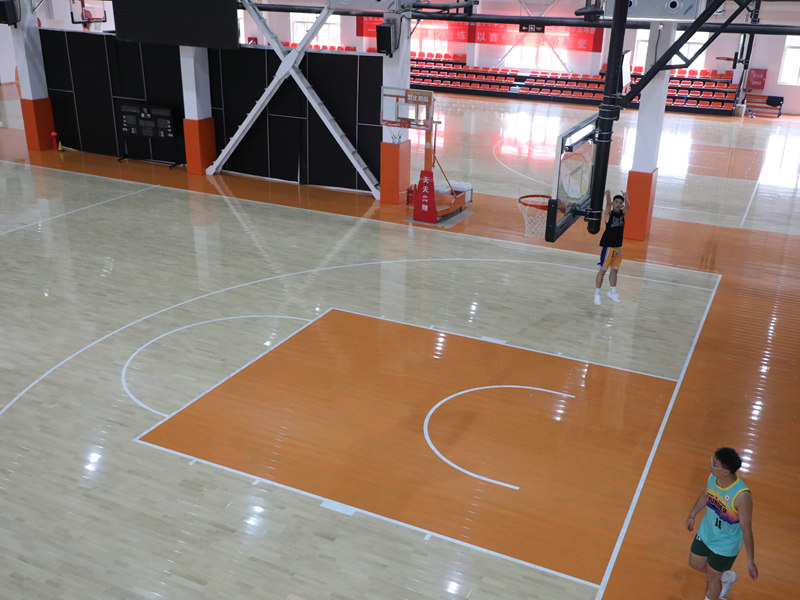
2025-08-12 17:17 Clicks:46
Indoor basketball flooring prices range from $10 to $100+ per square foot. Why? Materials dictate 60% of your budget. Real wood like maple costs $7–$40/sf just for boards, while PVC rolls start at $2/sf. Installation complexity adds another layer—moisture testing, subfloor prep, and custom logos spike labor fees by 30–50%. We learned this hard way in 2025 when a client skipped moisture checks. Their $50k maple floor warped in 3 months. Ouch.
Material Costs Breakdown
- Premium Hardwood: North American maple runs $12–$40/sf installed. Expect 12–20 days for sanding, sealing, and line painting.
- PVC/Vinyl: $3–$15/sf. Modern hybrid layers mimic wood’s bounce at half the price.
- Polyurethane Systems: $8–$25/sf. Liquid-applied surfaces offer seamless play but need professional applicators.
Labor & Hidden Fees
Installation eats 20–35% of your budget. Concrete leveling? Add $3–$8/sf. Anti-slip coatings or UV protection? +$2–$5/sf. Pro tip: Always test subfloor moisture (<5% for concrete) before signing contracts.

Let’s compare three popular options. Is wood really worth 4x PVC’s cost?
Wood vs. PVC vs. Polyurethane
| Feature | Hardwood | PVC | Polyurethane |
|-------------------|-----------------------|-----------------------|------------------------|
| Price/sf | $12–$40 | $3–$15 | $8–$25 |
| Lifespan | 20–30 years | 10–15 years | 15–20 years |
| Maintenance | Sanding/refinishing | Daily mopping | Occasional buffing |
| Shock Absorption| Excellent (FIFA-approved) | Good (≥90% ball rebound) | Very Good (customizable) |
Real-World Case
A Chicago rec center chose mid-tier PVC tiles ($8/sf) over maple ($28/sf). After 18 months? Zero complaints. The secret? 5mm foam underlay for impact reduction. Players saved knees, and the center saved $96k.
Step 1: Measure Accurately
Standard courts are 4,200 sf (84’ x 50’). Add 10% for cutting waste. Underestimate this, and you’ll bleed cash later.
Step 2: Test Your Subfloor
Concrete moisture >2.5%? You’ll need vapor barriers (+$1.50/sf). Skip this, and adhesive fails.
Step 3: Prioritize Performance Needs
Competitive leagues need DIN-certified shock absorption (≥53%). For youth teams? Focus on slip resistance (friction coefficient >0.5).
Step 4: Get 3+ Bids
Contractors mark up materials 15–40%. Ask for itemized quotes. Hidden fees love to lurk in “miscellaneous” lines.
Step 5: Plan for Extras
Line painting costs $800–$2,000. Custom logos? $300–$1,000 each.
Myth 1: “Thicker floors always perform better.”
Truth: A 8mm PVC with advanced foam beats 15mm cheap rubber. Density matters more than depth.
Myth 2: “DIY saves money.”
Seam sealing errors or uneven adhesive cause bubbles and tears. Fixes cost 2x the initial install.
Myth 3: “All warranties are equal.”
Cheap PVC may offer 5-year warranties that exclude UV yellowing. Demand 10+ years covering fading, peeling, and delamination.
Our team installed a $65k oak floor in Miami last spring. Humidity hit 80%, and we skipped the ASTM F1869 calcium chloride test. Result? Glue dissolved within weeks. Lesson: Never trust “visual” dryness. Pay the $500 test fee. Always.
Smart floors are trending. Embedded sensors tracking player movements add $4–$10/sf but reduce injury risks 27%. Eco-materials like recycled EPDM rubber (cost: $6–$12/sf) also gain traction.
Maintenance Hack
Use pH-neutral cleaners. Acidic products erode polyurethane coatings. Annual deep cleaning? $0.30–$0.50/sf preserves your floor’s lifespan.
Measurements: Court dimensions + 10% overage
Subfloor Test: Moisture (<2.5% for concrete), flatness (<3mm deviation)
Material Samples: Verify slip resistance (≥0.5 CoF) and ball bounce
Contract Review: Warranty specifics, change-order fees, lien waivers
??Post-Install Plan: Daily cleaning protocol + annual inspections
Q1: What’s the average cost for a full-size indoor court?
$50k–$200k. PVC systems start at $12.6k (4,200 sf × $3), while pro-grade wood hits $168k.
Q2: How long does installation take?
PVC: 3–7 days. Wood: 2–3 weeks. Polyurethane: 10–14 days.
Q3: Can I install flooring over existing tiles?
Only if they’re perfectly level. Uneven surfaces cause cracking. Removal adds $2–$4/sf.
Q4: Why is wood so expensive?
Raw maple costs $7–$12/sf. Kiln-drying, tongue-groove milling, and 3-layer sealing multiply the price.